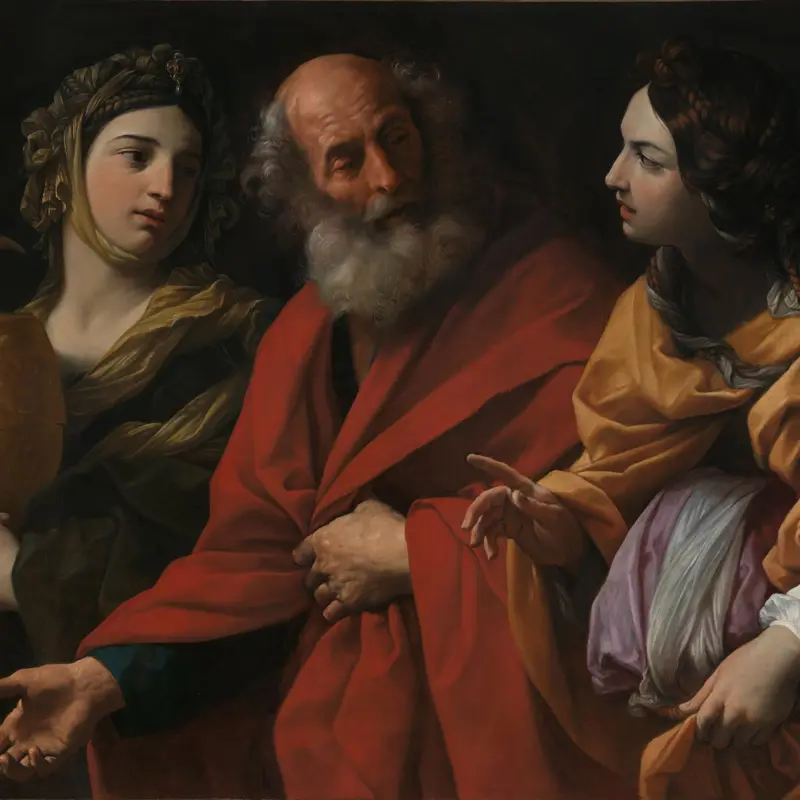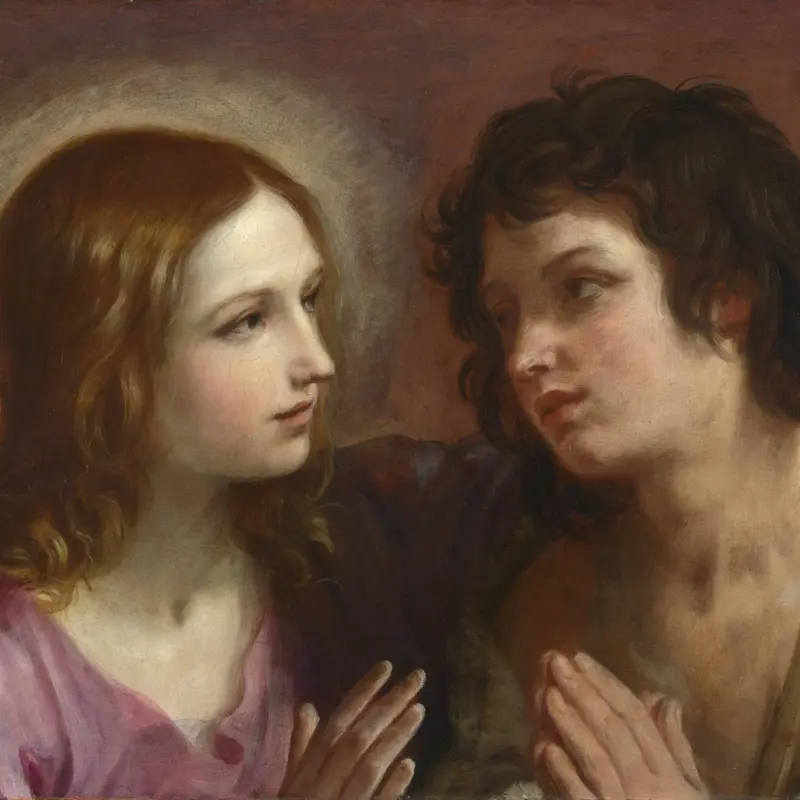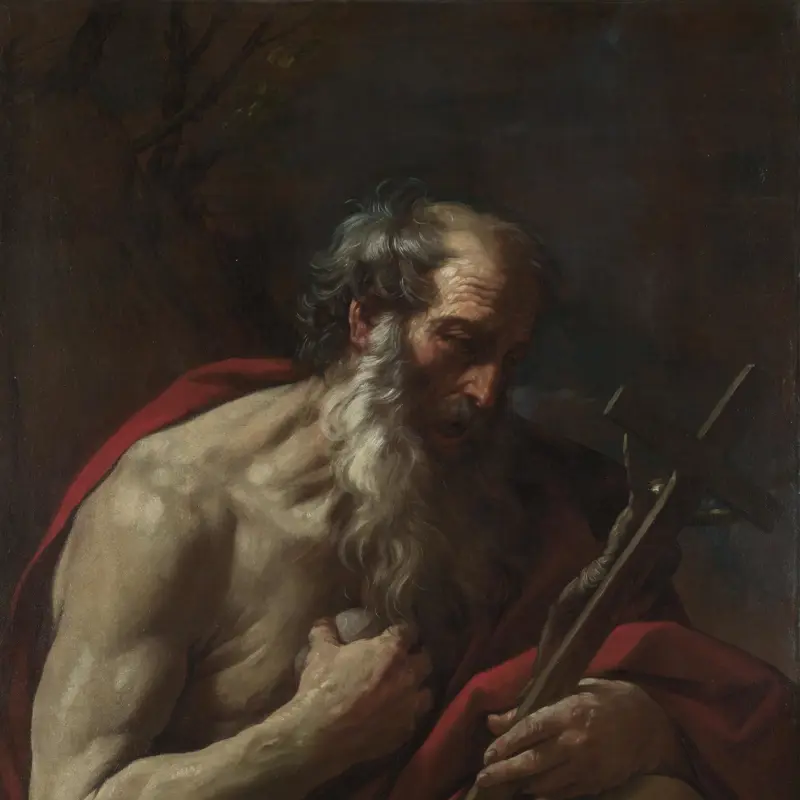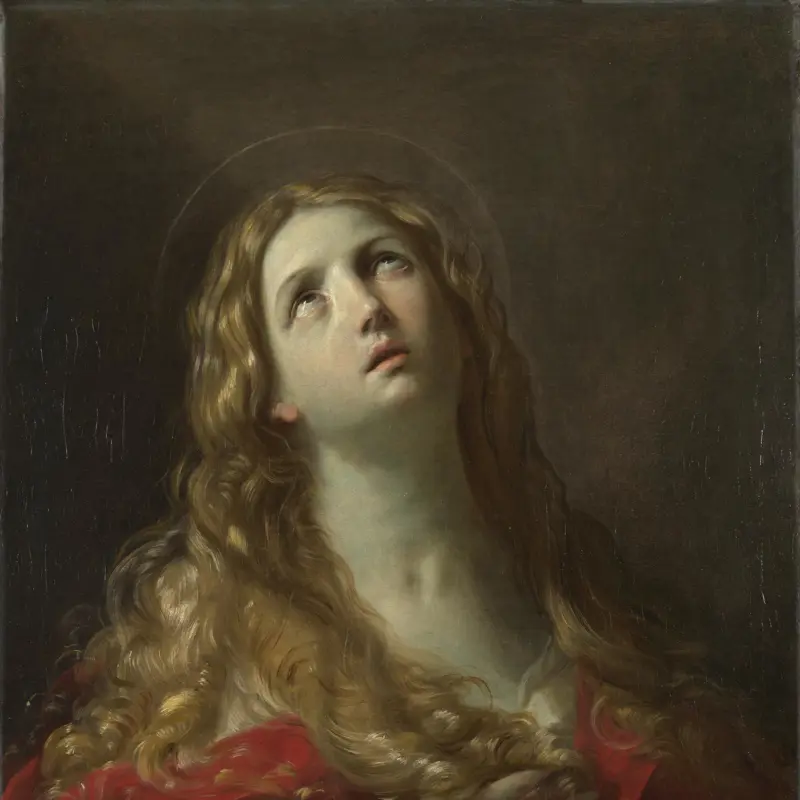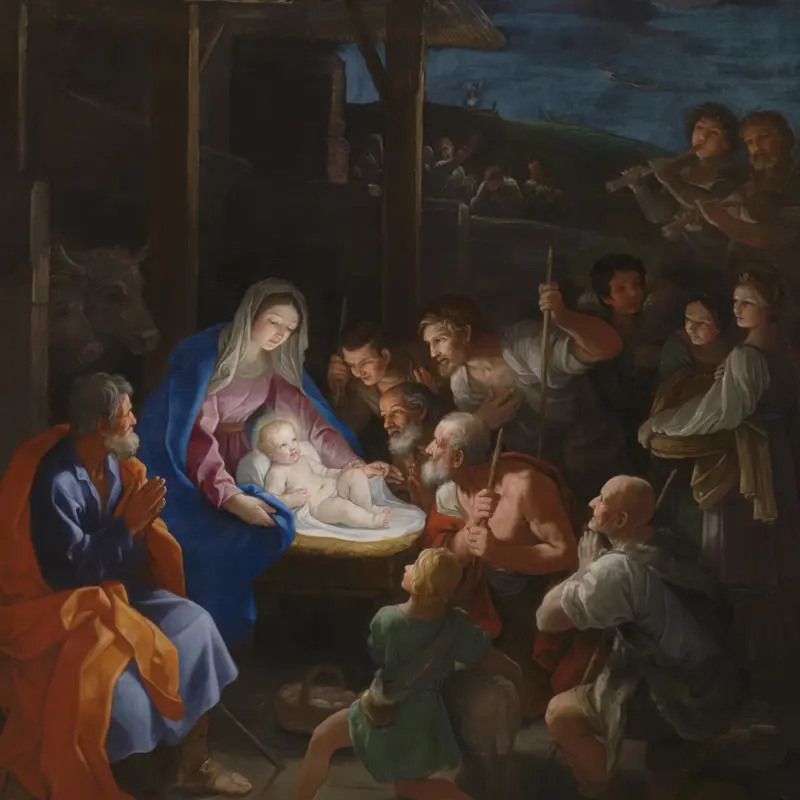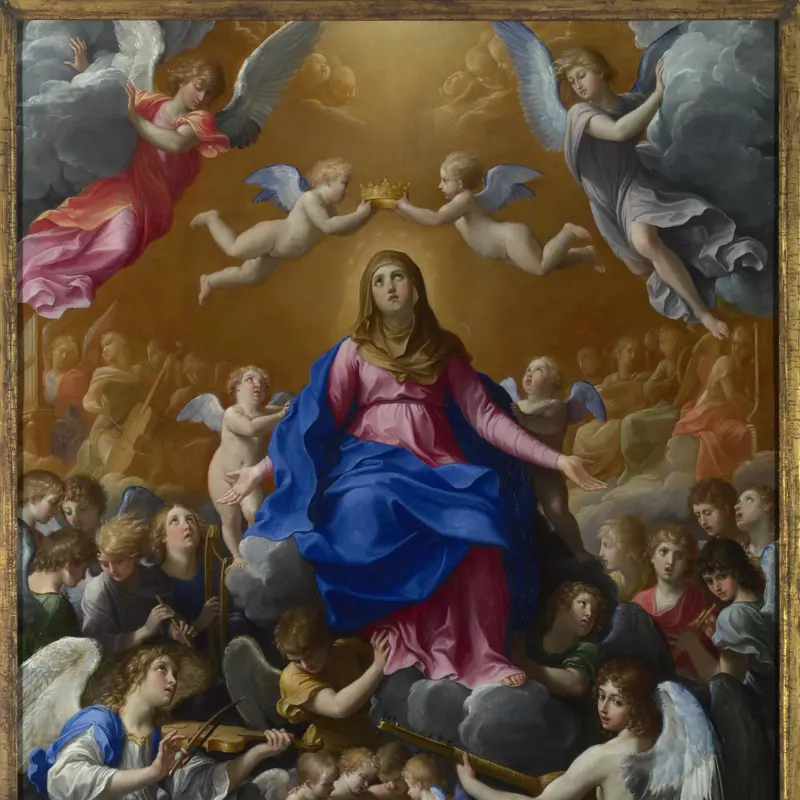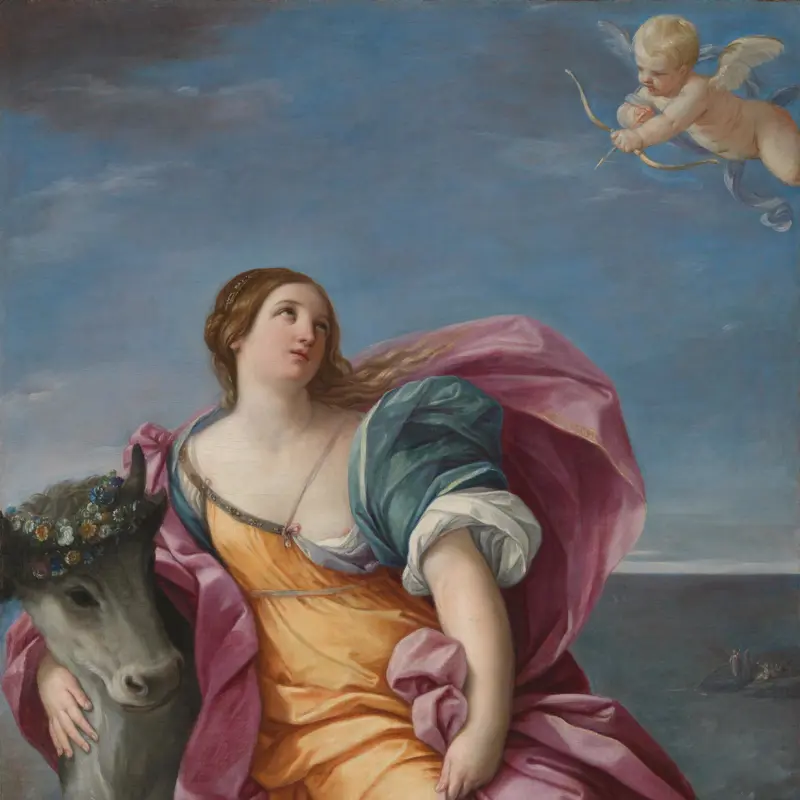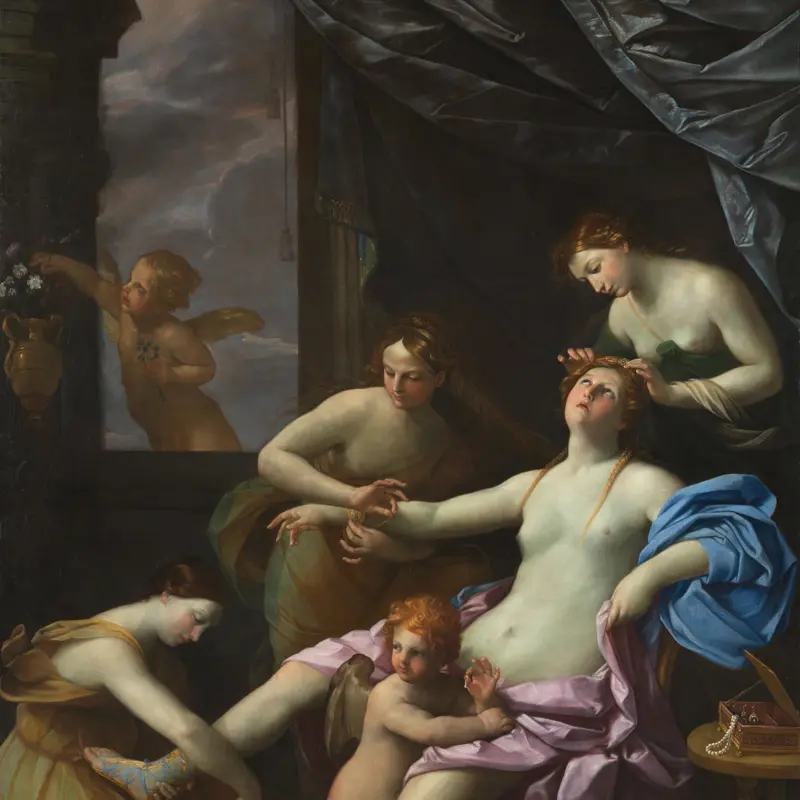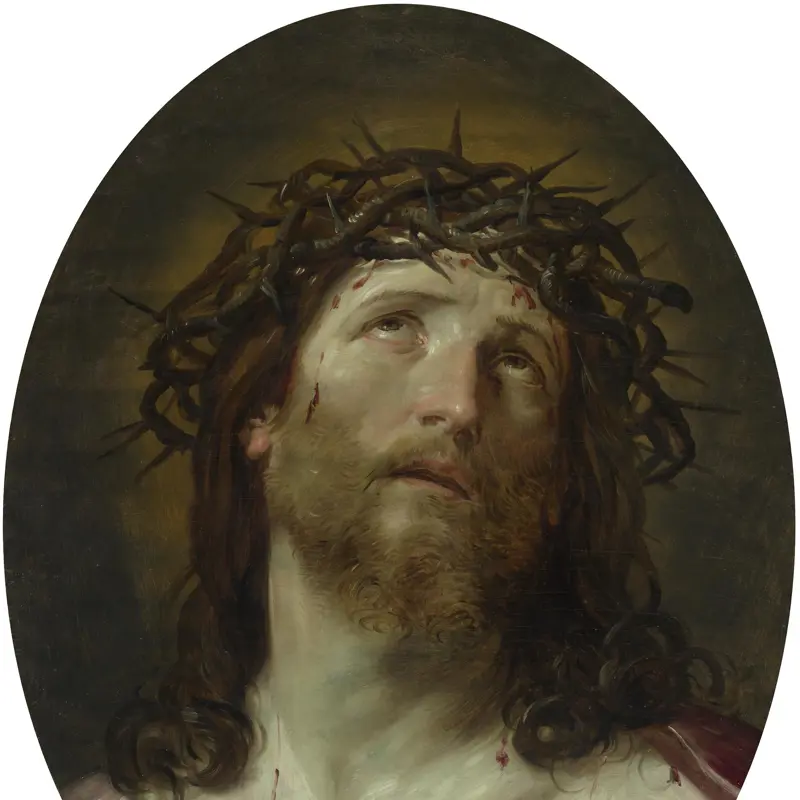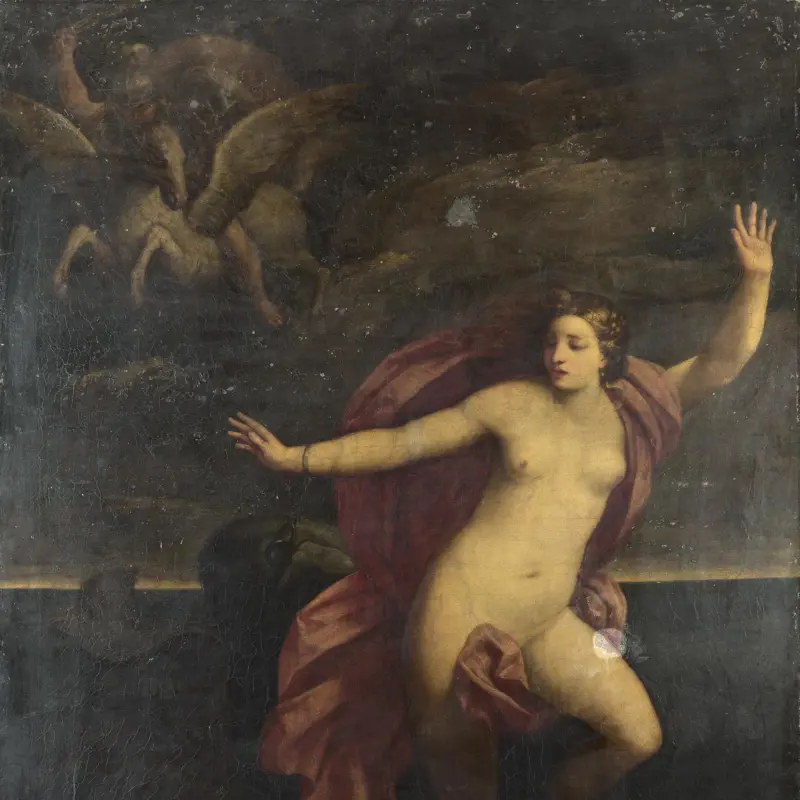Guido Reni, 'Susannah and the Elders', about 1622-3
About the work
Overview
An apocryphal addition to the Old Testament describes how two lecherous elders threatened to accuse Susannah, a beautiful young woman, of adultery – a crime punishable by death – if she did not give in to their desires. Guido Reni here illustrates the episode: one man grabs at Susannah’s robes and puts his fingers to his lips, commanding her silence, while the other raises a hand, ready to touch her. She grasps at her drapery, attempting to cover her breasts.
This painting hung in the Palazzo Lancellotti, Rome, in 1640, alongside Lot and his Daughters leaving Sodom, also now in the National Gallery’s collection. Given that the paintings are of a similar size, it was believed for some time that they were created as companion pieces. However, cleaning in 1984 revealed brushwork that suggests different dates for the works – Susannah and the Elders was painted later than Lot and his Daughters and the two were likely not originally intended as a pair.
Key facts
Details
- Full title
- Susannah and the Elders
- Artist
- Guido Reni
- Artist dates
- 1575 - 1642
- Part of the series
- Two Biblical Scenes from Palazzo Lancellotti
- Date made
- About 1622-3
- Medium and support
- Oil on canvas
- Dimensions
- 116.6 × 150.5 cm
- Acquisition credit
- Bought, 1844
- Inventory number
- NG196
- Location
- Room 32
- Collection
- Main Collection
- Previous owners
- Frame
- 17th-century Italian Frame
Provenance
Additional information
Text extracted from the ‘Provenance’ section of the catalogue entry in Michael Levey, ‘National Gallery Catalogues: The Seventeenth and Eighteenth Century Italian Schools’, London 1986; for further information, see the full catalogue entry.
Exhibition history
-
2022Guido Reni: The Beauty of the DivineStädelsches Kunstinstitut und Städtische Galerie23 November 2022 - 5 March 2023Museo Nacional del Prado28 March 2023 - 9 July 2023
Bibliography
-
1660D. Teniers, Theatrum Pictorium, Brussels 1660
-
1787F.W.B. von Ramdohr, Über Mahlerei und Bildhauerarbeit in Rom für Liebhaber des Schönen in der Kunst, Leipzig 1787
-
1824W. Buchanan, Memoirs of Painting: With a Chronological History of the Importation of Pictures by the Great Masters into England Since the French Revolution, London 1824
-
1842G. Robins, The Splendid Property of Every Denomination Appertaining to Shugborough Hall, Shugborough, 10 August 1842
-
1844Christie & Manson, Catalogue of the Celebrated Collection of Pictures, of the Very Highest Class: The Property of John Penrice, Esq., London, 16 July 1844
-
1845T. Penrice, Letters Addressed to the Late Thomas Penrice, Esq., while Engaged in Forming His Collection of Pictures, 1808-1814, ed. J. Penrice, Yarmouth 1845
-
1853National Gallery, Report from the Select Committee on the National Gallery, together with the Proceedings of the Committee, Minutes of Evidence, Appendix, and Index, London 1853
-
1853London, National Gallery Archive, NG15/3: Report from the Select Committee on the National Gallery, together with the Proceedings of the Committee, Minutes of Evidence, Appendix, and Index, 1853
-
1878H. Blackburn, Illustrated Catalogue to the National Gallery: Foreign Schools, London 1878
-
1888E.T. Cook, A Popular Handbook to the National Gallery Including, by Special Permission, Notes Collected from the Works of Mr. Ruskin, London 1888
-
1928W.T. Whitley, Art in England 1800-1820, Cambridge 1928
-
1937O. Kurz, 'Guido Reni', Jahrbuch der Kunsthistorischen Sammlungen in Wien, II, 1937, pp. 189-220
-
1971E. Baccheschi, L'opera completa di Guido Reni, Milan 1971
-
1971M. Levey, The Seventeenth and Eighteenth Century Italian Schools, London 1971
-
1975E. Borea, Pittori bolognesi del Seicento nelle Gallerie di Firenze (exh. cat. Uffizi, February - April 1975), Florence 1975
-
1978D. Robertson, Sir Charles Eastlake and the Victorian Art World, Princeton 1978
-
1981H. Braham, The Princes Gate Collection, London 1981
-
1981V. Birke, Guido Reni Zeichnungen (exh. cat. Albertina, 14 May - 5 July 1981), Vienna 1981
-
1982H. Brigstocke and W. Buchanan, William Buchanan and the 19th Century Art Trade: 100 Letters to his Agents in London and Italy, London 1982
-
1982E. Negro and M. Pirondini, La scuola di Guido Reni, Modena 1982
-
1983National Gallery, 'Pictures Cleaned and Restored in the Conservation Department of the National Gallery, January 1983 – December 1983', National Gallery Technical Bulletin, VIII, 1984, pp. 71-2
-
1984D.S. Pepper, Guido Reni: A Complete Catalogue of His Works, Oxford 1984
-
1986Levey, Michael, National Gallery Catalogues: The Seventeenth and Eighteenth Century Italian Schools, London 1986
-
1986M. Helston, 'Some Recently Cleaned Seicento Paintings at the National Gallery', The Burlington Magazine, CXXVIII/996, 1986, pp. 209-17
-
1988D.S. Pepper, Guido Reni: L'opera completa, Novara 1988
-
1988V. Birke and B. Dossi, Guido Reni und der Reproduktionsstich, (exh. cat. Albertina, 15 September - 13 November 1988), Vienna 1988
-
1988S. Ebert-Schifferer et al., Guido Reni und Europa: Ruhm und Nachruhm (exh. cat. Schirn Kunsthalle, 2 December 1988 - 26 February 1989), Frankfurt 1988
-
1990S. Loire, 'Guido Reni dopo la mostra di Bologna: Qualche aggiunta', Atti e memorie dell'Accademia Clementina, XXV, 1990, pp. 4-30
-
1990D.S. Pepper, 'Afterthoughts on the Guido Reni Exhibition', Atti e memorie dell'Accademia Clementina, XXV, 1990
-
1991J.C. Prêtre, 'Suzanne par Suzanne, un essai d'iconographie', in J.C. Prêtre, Suzanne: Le procès du modèle, Paris 1991, pp. 29-127
-
1992M. Scolaro, 'Guido Reni', in A. Emiliani (ed.), La pittura in Emilia e in Romagna, Milan 1992, vol. 2, pp. 157-69
-
1994B. Sarrazin (ed.), Catalogue raisonné des peintures italiennes du musée des beaux-arts de Nantes, Nantes 1994
-
1995H.H. Hofstätter, 'Susanna und die beiden Alten', Das Münster, XLVIII, 1995, pp. 276-279, 365-9
-
1997R.E. Spear, The 'Divine' Guido: Religion, Sex, Money, and Art in the World of Guido Reni, New Haven 1997
-
1999G. Cosmo, 'Guido Reni tra Masaccio e Caravaggio: Debiti e tributi', Art e dossier, 1999, pp. 35-8
-
1999R. Walker, 'Henry Bone's Pencil Drawings in the National Portrait Gallery', The Walpole Society, LXI, 1999, pp. 305-67
-
2000A. Emiliani, 'Guido Reni', in E. Borea (ed.), L'idea del bello: Viaggio per Roma nel Seicento con Giovan Pietro Bellori, Rome 2000, vol. 2, pp. 342-54
-
2001
C. Baker and T. Henry, The National Gallery: Complete Illustrated Catalogue, London 2001
-
2004A. Brogi, 'Una piccola Pommersfelden? Dipinti italiani della collezione Schaumberg-Lippe. II. Guido Reni', Paragone, 55-56, 2004, pp. 89-97
About this record
If you know more about this work or have spotted an error, please contact us. Please note that exhibition histories are listed from 2009 onwards. Bibliographies may not be complete; more comprehensive information is available in the National Gallery Library.
Images
About the series: Two Biblical Scenes from Palazzo Lancellotti
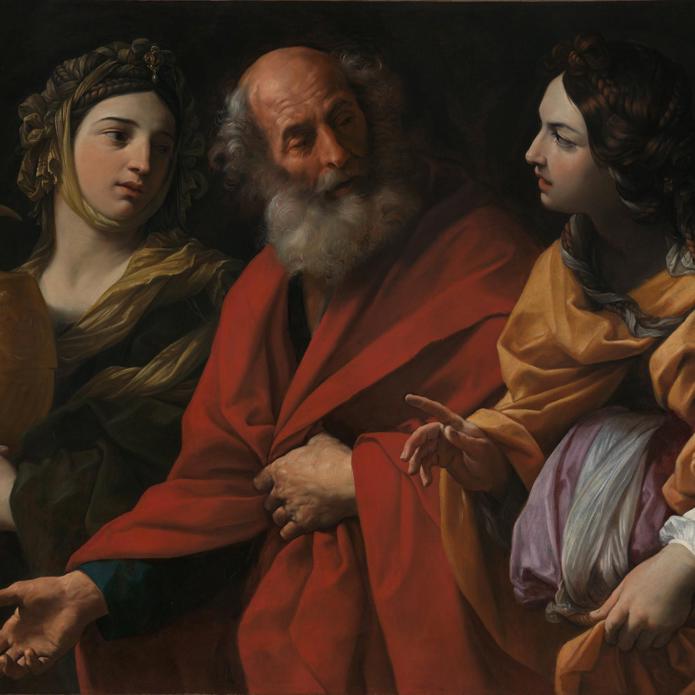
Overview
Lot and his Daughters Leaving Sodom and Susannah and the Elders are two works by Guido Reni, both of which depict biblical scenes containing three figures. They are of similar size, and are painted in a horizontal format with dark backgrounds. The two were first recorded in the Palazzo Lancellotti, Rome, in 1640, where they hung together as companion pieces until they were respectively acquired by the National Gallery in 1844.
Upon their acquisition the works were considered to be a pair, given their similarly moralising subject matter, size, and location in the Palazzo Lancellotti. However, cleaning revealed brushwork that suggests the paintings were created in different periods of Reni’s career, and were not made to hang together.
Because the two Old Testament subjects illustrate feminine vice and virtue, the pairing would seem to be deliberate. It’s possible that Reni painted Susannah and the Elders to accompany his earlier work, but it’s similarly plausible that the pairing was made by a collector much later.

